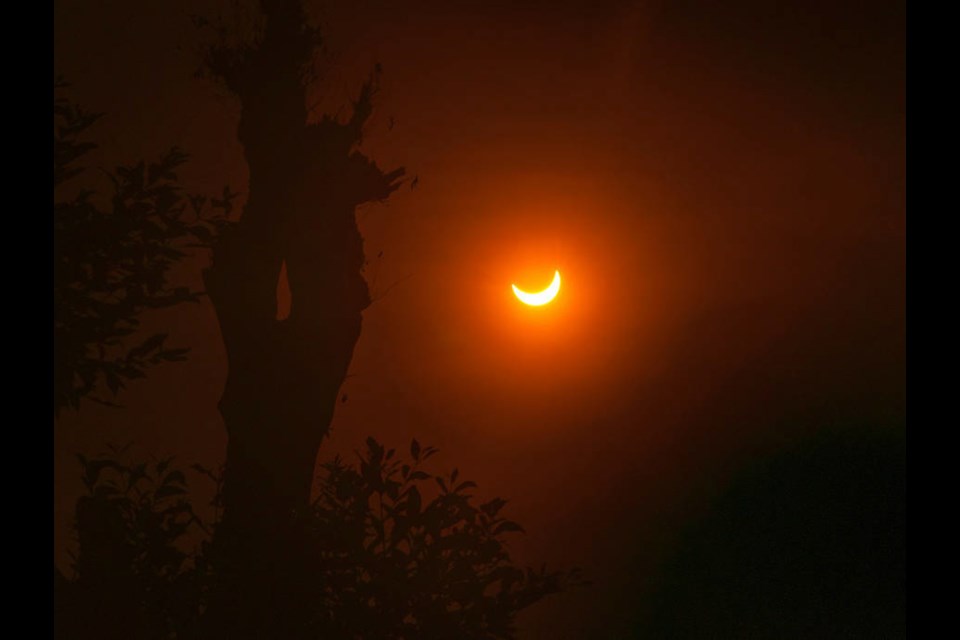On August 21 a total solar eclipse will be visible from 14 states in America and, while only a partial eclipse will be visible here in Sault Ste. Marie, experts say there are precautions people should take not to damage their eyes.
A total solar eclipse occurs when the moon blocks the light of the sun, turning it into a dark sphere surrounded by a fiery ring.
The Sault is out of the path of the main eclipse but around 70 per cent of the sun will be covered locally, still making for a spectacle.
According to the website eclipsewise.com, the eclipse will begin at 1 p.m. on Monday, peak at 2:20pm, and end at 3:37 pm.
However, people need to be careful.
If you look at the eclipse without protection "you won’t know you’ve damaged your eyes until its already permanent," said Dr. Michael Burns of Station Tower Optometry.
“Normally when you look at the sun it hurts, but during an eclipse it doesn't so normally the people will look at the sun longer and it will do damage,” said Burns.
Burns said the damage could leave a person with blurry or dark spots in their central vision.
“You wouldn’t be able to drive, hard time reading, hard time identifying faces,” he said.
NASA says the solar eclipse can be viewed safely using special purpose filters like ‘eclipse glasses’.
Regular sunglasses permit ‘thousands of times too much sunlight’ to be useful, says NASA.
It’s important, says NASA, when using filters or glasses that they are made by a reputable source.
It was widely reported that Amazon.com had to recall eclipse glasses after their safety could not be verified.
NASA also suggests people can use home-made pinhole viewing device, or welding goggles — but only those that have a 12-shade rating or darker. NASA notes No. 12 welding glass is "much darker than the filters used for most kinds of welding" and is uncommon.
More information on eclipses can be found at the Canadian Space Agency's website.
Unfortunately, it is not clear if glasses are available locally.
Best Buy did have some but they are sold out and Walmart, the Source, and the public library don't have any for sale.
On Monday, provided the sky is clear, Lake Superior State University is setting up telescopes for public viewing of the eclipse.
The following is a press release sent out by the university:
*************************
SAULT STE. MARIE, Mich. – Provided the sky is not overcast, Lake Superior State University faculty from the School of Physical Sciences will have solar-filtered telescopes set up for public viewing of Monday's a partial eclipse of the sun, from 1-3 p.m. Observing takes place on the sidewalk between Crawford Hall and the Shouldice Library. Professors will share solar sunglasses and filters to safely view the eclipse without a telescope.
A solar eclipse happens when the moon passes in front of the sun along our line of sight. On Aug. 21, all of North America will view a partial eclipse, when the moon obscures part of the sun. A total eclipse will only be visible inside of a 70-mile-wide path that crosses 14 of the United States from Oregon to South Carolina.
Sault Ste. Marie, well north of this path of totality, will see just more than two-thirds of the sun's disk covered the moon. For the Sault, the sun's brightness in the sky will appear unaffected. Visual effects, such as the appearance of a sunny day viewed through dense polarized sunglasses, only become visible when more than 90% of the sun is covered.
For Sault Ste. Marie, the eclipse starts at 1 p.m. when the moon's silhouette appears to take a tiny bite out the right edge of the sun. Mid-eclipse, when the moon's bulk covers 68% of the solar disk, is at 2:20 p.m. The eclipse formally ends at 3:37 p.m. when our moon's curved shadow exits the sun's far left edge.
The only safe way to look directly at a partially eclipsed sun is through special-purpose solar filters, such as ISO 12312-2 safety-certified eclipse glasses or handheld solar viewers. Homemade filters or ordinary sunglasses, even very dark ones, are not safe for looking at the sun.
An alternative method for safe viewing of the partially eclipsed sun is pinhole projection. In this method, you don’t look directly at the sun, but at a projection on a piece of paper or even the ground. For example, cross the outstretched, slightly open fingers of one hand at right angles over the outstretched, slightly open fingers of the other. Do not look at your hands, but at the shadow of your hands on the ground. The little spaces between your fingers will project a grid of small images, showing the sun with a bite out of it during the partial phases of the eclipse.
That failing, nature has ready-made pinhole solar projectors all around us. Note leafy tree shadows on the ground and against buildings 15 minutes either side of mid-eclipse. Dappled sunlight will take on shapes of fat crescents.
*************************
